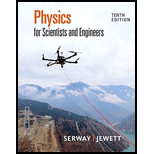
Review. A fundamental property of a type 1 superconducting material is perfect diamagnetism, or demonstration of the Meissner effect, illustrated in Figure 29.27 in Section 29.6 and described as follows. If a sample of superconducting material is placed into an externally produced magnetic field or is cooled to become superconducting while it is in a magnetic field,
A vertical solenoid with a length of 120 cm and a diameter of 2.50 cm consists of 1 400 turns of copper wire carrying a counterclockwise current (when viewed from above) of 2.00 A as shown in Figure P31.48a. (a) Find the magnetic field in the vacuum inside the solenoid. (b) Find the energy density of the magnetic field. Now a superconducting bar 2.20 cm in diameter is inserted partway into the solenoid. Its upper end is far outside the solenoid, where the magnetic field is negligible. The lower end of the bar is deep inside the solenoid. (c) Explain how you identify the direction required for the current on the curved surface of the bar so that the total magnetic field is zero within the bar. The field created by the supercurrents is sketched in Figure P31.48b, and the total field is sketched in Figure P31.48c. (d) The field of the solenoid exerts a force on the current in the superconductor. Explain how you determine the direction of the force on the bar. (e) Noting that the units J/m3 of energy density are the as the units N/m2 of pressure, calculate the magnitude of the force by multiplying the energy density of the solenoid field times the area of the bottom end of the superconducting bar.
Figure P31.48

Want to see the full answer?
Check out a sample textbook solution
Chapter 31 Solutions
Physics:f/sci.+engrs.,ap Ed.
- Plz no chatgpt Iarrow_forwardA = 45 kN a = 60° B = 20 kN ẞ = 30° Problem:M1.1 You and your friends are on an archaeological adventure and are trying to disarm an ancient trap to do so you need to pull a log straight out of a hole in a wall. You have 1 rope that you can attach to the log and there are currently 2 other ropes and weights attached to the end of the log. You know the force and direction of the ropes currently attached are arranged as shown below what is the magnitude and direction 'e' of the minimum force you need to apply to the third rope for the force on the log to be in direction of line 'a'? What is the resultant force in direction 'a'? a ////// //////arrow_forwardanswer both questionsarrow_forward
- - 13- 3. Shastri recalled reading that for an ideal transformer, "the ratio of the primary voltage to the secondary voltage is equal to the ratio of the secondary current to the primary current." Plan and design an experiment to investigate whether the statement above is true. (8) • With the aid of a fully labelled circuit diagram, describe a procedure which can be used to investigate whether the statement is true. The circuit diagram must include the following components: A variable AC voltage supply • AC voltmeters • AC ammeters A transformer with adjustable turns ratio Connecting wires • ° A load resistorarrow_forwardanswer question 1-6arrow_forwardFractions 1. Covert 5/7 to a decimal 2. 5/7 x 3/8 3. 2/5 divided 4/9 4. covert 37/ 19 to a decimalarrow_forward
- this is an exam past paper question that i need help with becuase i am reviewing not a graded assignmentarrow_forwardsunny (1) -13- end. One box contains nothing inside; one has a piece of resistance wire between the terminals You are provided with three sealed identical matchboxes labelled A, B and C, with terminals at each and the other, a semi-conductor diode. Plan and design an experiment to identify the contents of each box. You are provided with the following elements for your apparatus: Ammeter Low voltage power supply Connecting wires Labelled circuit diagram Draw a well-labelled circuit diagram to show how you would connect the apparatus listed above to each matchbox. (3 maarrow_forwardRAD127 Radiographic Equipment and Computers SI Units in Radiography Ch. 1 & 2 Instructions: Provide the units for each of the following in full and short forms 1. Mass - kg, 9 or (1b)) ・ 2. Energy, Work - W = FD,J 3. Air kerma -(Gya) 4. Absorbed Dose- 5. Effective Dose J/kg (94+) jlkg J/kg, Sv 6. Radioactivity - 5-1, Bq 7. Weight 8. Time 9. Force 10. Power B9 wt, wt-mg, N -(s) F= ma, N, OR 1b. (JIS), P= work It = Fdlt, Jarrow_forward
- answer 1-8arrow_forward1 . Solve the equation 2/7=y/3 for y. 2. Solve the equation x/9=2/6 for x. 3. Solve the equation z + 4 = 10 This is algebra and the equation is fraction.arrow_forwardtwo satellites are in circular orbits around the Earth. Satellite A is at an altitude equal to the Earth's radius, while satellite B is at an altitude equal to twice the Earth's radius. What is the ratio of their periods, Tb/Taarrow_forward

 Modern PhysicsPhysicsISBN:9781111794378Author:Raymond A. Serway, Clement J. Moses, Curt A. MoyerPublisher:Cengage Learning
Modern PhysicsPhysicsISBN:9781111794378Author:Raymond A. Serway, Clement J. Moses, Curt A. MoyerPublisher:Cengage Learning Physics for Scientists and EngineersPhysicsISBN:9781337553278Author:Raymond A. Serway, John W. JewettPublisher:Cengage Learning
Physics for Scientists and EngineersPhysicsISBN:9781337553278Author:Raymond A. Serway, John W. JewettPublisher:Cengage Learning Physics for Scientists and Engineers with Modern ...PhysicsISBN:9781337553292Author:Raymond A. Serway, John W. JewettPublisher:Cengage Learning
Physics for Scientists and Engineers with Modern ...PhysicsISBN:9781337553292Author:Raymond A. Serway, John W. JewettPublisher:Cengage Learning Physics for Scientists and Engineers, Technology ...PhysicsISBN:9781305116399Author:Raymond A. Serway, John W. JewettPublisher:Cengage Learning
Physics for Scientists and Engineers, Technology ...PhysicsISBN:9781305116399Author:Raymond A. Serway, John W. JewettPublisher:Cengage Learning Principles of Physics: A Calculus-Based TextPhysicsISBN:9781133104261Author:Raymond A. Serway, John W. JewettPublisher:Cengage Learning
Principles of Physics: A Calculus-Based TextPhysicsISBN:9781133104261Author:Raymond A. Serway, John W. JewettPublisher:Cengage Learning





